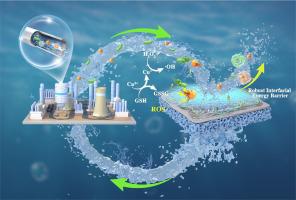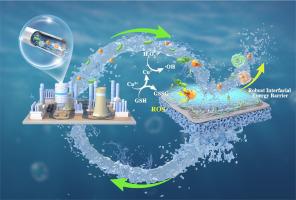双屏蔽抗菌薄膜复合膜,结合ros介导的生物杀灭作用和热力学抗粘附作用,用于可持续冷却水处理
IF 12.4
1区 环境科学与生态学
Q1 ENGINEERING, ENVIRONMENTAL
引用次数: 0
摘要
为了缓解全球的水危机,膜技术被广泛应用于冷却水回用工艺中。然而,工业废热引起的微生物过度生长导致了严重的膜生物污染。本研究通过极简方法在商用膜表面构建了由单宁酸(TA)、铜(Cu)和聚乙烯亚胺(PEI)组成的定制装甲涂层。该涂层通过Cu 2 +催化活性氧(ROS)生成,对浮游细菌具有优异的根除效率(95%)。改性后,膜与细菌共聚集体之间的平均粘附力从11.5 nN显著降低到7.58 nN。此外,细胞外聚合物(EPS)组分在膜表面的粘附倾向显著降低。这是由于金属-多酚网络(MPN)提供了坚固的水合层,这大大提高了膜的表面能屏障和粘附阻力。长期的合成废水测试表明,强大的双作用抗污机制确保了高效的生物膜抑制能力,有效地延长了纳滤膜的使用寿命。这项工作拓展了mpn基材料在膜领域的应用,为抗菌膜表面的开发提供了一个极简而高效的创新范例。本文章由计算机程序翻译,如有差异,请以英文原文为准。


Dual-shielded antibacterial thin-film composite membrane unifying ROS-mediated biocidal action and thermodynamic anti-adhesion for sustainable cooling water treatment
To alleviate the global water crisis, membrane technology is widely employed in cooling water reuse processes. However, excessive microbial growth induced by industrial waste heat leads to severe membrane biofouling. This study constructed a customized armor coating composed of tannic acid (TA), copper (Cu), and polyethylenimine (PEI) on a commercial membrane surface via a minimalist approach. The coating achieved superior eradication efficiency (>95 %) against planktonic bacteria through Cu²⁺-catalyzed reactive oxygen species (ROS) generation. The average adhesion force between the membrane and bacterial coaggregates decreased significantly from 11.5 nN to 7.58 nN following modification. Furthermore, extracellular polymeric substance (EPS) components exhibited significantly reduced adhesion propensity on the membrane surface. This is attributed to the robust hydration layer provided by the metal-polyphenol network (MPN), which substantially elevated the membrane's surface energy barrier and adhesion resistance. Long-term synthetic wastewater testing demonstrates that a robust dual-action anti-fouling mechanism ensures highly efficient biofilm suppression capability, effectively extending the lifespan of nanofiltration membranes. This work expands the application of MPN-based materials in the membrane field, providing a minimalist yet highly efficient and innovative paradigm for developing antibacterial membrane surfaces.
求助全文
通过发布文献求助,成功后即可免费获取论文全文。
去求助
来源期刊

Water Research
环境科学-工程:环境
CiteScore
20.80
自引率
9.40%
发文量
1307
审稿时长
38 days
期刊介绍:
Water Research, along with its open access companion journal Water Research X, serves as a platform for publishing original research papers covering various aspects of the science and technology related to the anthropogenic water cycle, water quality, and its management worldwide. The audience targeted by the journal comprises biologists, chemical engineers, chemists, civil engineers, environmental engineers, limnologists, and microbiologists. The scope of the journal include:
•Treatment processes for water and wastewaters (municipal, agricultural, industrial, and on-site treatment), including resource recovery and residuals management;
•Urban hydrology including sewer systems, stormwater management, and green infrastructure;
•Drinking water treatment and distribution;
•Potable and non-potable water reuse;
•Sanitation, public health, and risk assessment;
•Anaerobic digestion, solid and hazardous waste management, including source characterization and the effects and control of leachates and gaseous emissions;
•Contaminants (chemical, microbial, anthropogenic particles such as nanoparticles or microplastics) and related water quality sensing, monitoring, fate, and assessment;
•Anthropogenic impacts on inland, tidal, coastal and urban waters, focusing on surface and ground waters, and point and non-point sources of pollution;
•Environmental restoration, linked to surface water, groundwater and groundwater remediation;
•Analysis of the interfaces between sediments and water, and between water and atmosphere, focusing specifically on anthropogenic impacts;
•Mathematical modelling, systems analysis, machine learning, and beneficial use of big data related to the anthropogenic water cycle;
•Socio-economic, policy, and regulations studies.
 求助内容:
求助内容: 应助结果提醒方式:
应助结果提醒方式:


